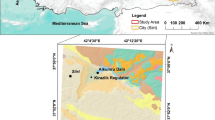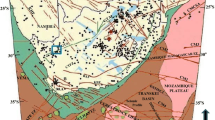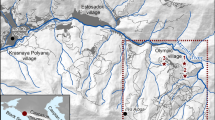Abstract
The presence of polygonal-shaped craters, i.e., craters with complete or incomplete polygonal rims along with circular or elliptical outlines, on the surface of celestial bodies has been known for nearly a century. However, many investigations on their distribution and formation have not been carried out, until recently. Scientists have proposed that the polygonal shapes of the crater rims owe their origin to the pre-existing structurally weak planes like faults/fractures in the area adjacent to the impact. The present study area is the southern part of Margaritifer Terra, Mars; a mid-Noachian terrain, which has craters of different morphologies, including the polygonal impact craters (PICs). The study focuses on the reason for the development of PICs by identification and mapping of a population of 50 selected polygonal craters along with morphotectonic features namely grabens, wrinkle ridges, and lobate scarps. The analysis of orientations of the straight segments of polygonal crater rims shows marked resemblance with orientations of these morphotectonic features conforming to their control on the rim geometries.
Research highlights
-
Structural mapping of the southern Margaritifer Terra region, Mars.
-
Generating rose diagrams and line graphs for the orientation of the straight edges of polygonal craters and the morphotectonic features within the southern Margaritifer Terra region.
-
Conducting statistical F-test to find out the bearing of weak planes on the formation of PICs.
-
Finding out the presence of buried weak planes by comparing the rose diagrams and spike graphs.






Similar content being viewed by others
References
Anders E and Arnold J R 1965 Age of craters on Mars; Science 149(3691) 1494–1496.
Anderson R C, Dohm J M, Golombek M P, Haldemann A F, Franklin B J, Tanaka K L, Lias J and Peer B 2001 Primary centers and secondary concentrations of tectonic activity through time in the western hemisphere of Mars; J. Geophys. Res. Planets 106(E9) 20,563–20,585.
Arya A S, Sarkar S S, Srinivas A R, Moorthi S M, Patel V D, Singh R B, Rajasekhar R P, Roy S, Misra I, Paul S K and Shah D 2015 Mars Colour Camera: The payload characterization/calibration and data analysis from Earth imaging phase; Curr. Sci. 109.
Bamberg M, Jaumann R, Asche H, Kneissl T and Michael G G 2014 Floor–fractured craters on Mars–observations and origin; Planet. Space Sci. 98 146–162.
Baul S and Dasgupta D 2021 An appraisal of crustal deformation of the East Coprates Planum, Mars; Planet. Space Sci. 203 105252.
Christensen P R, Jakosky B M, Kieffer H H, Malin M C, McSween H Y, Nealson K, Mehall G L, Silverman S H, Ferry S, Caplinger M and Ravine M 2004 The thermal emission imaging system (THEMIS) for the Mars 2001 Odyssey Mission; Space Sci. Rev. 110(1–2) 85–130.
Dasgupta D, Kundu A, De K and Dasgupta N 2019 Polygonal impact craters in the Thaumasia Minor, Mars: Role of pre-existing faults in their formation; J. Indian Soc. Remote. Sens. 47(2) 257–265.
De K, Dasgupta N and Kundu A 2018 A statistical approach to decipher the tectonic control on the geometry of Martian channels: Case study from Pyrrhae Fossae, Noachis Terra, Mars; Planet. Space Sci. 164 174–183.
Eppler D T, Ehrlich R, Nummedal D and Schultz P H 1983 Sources of shape variation in lunar impact craters: Fourier shape analysis; Geol. Soc. Am. Bull. 94(2) 274–291.
Fergason R L, Hare T M and Laura J 2018 HRSC and MOLA Blended Digital Elevation Model at 200m v2; Astrogeology PDS Annex US Geol. Surv. http://bit.ly/HRSC_MOLA_Blend_v0.
Garvin J B, Sakimoto S E H and Frawley J J 2003 Craters on Mars: Global geometric properties from gridded MOLA topography; The 6th International Conference on Mars.
Irwin III R P and Grant J A 2013 Geologic map of MTM-15027, -20027, -25027, and -25032 quadrangles, Margaritifer Terra region of Mars; US Geol. Surv. Sci. Inv. Map 3209.
Malin M C, Bell J F, Cantor B A, Caplinger M A, Calvin W M, Clancy R T, Edgett K S, Edwards L, Haberle R M, James P B and Lee S W 2007 Context camera investigation on board the Mars Reconnaissance Orbiter; J. Geophys. Res. Planets 112(E5).
Öhman T, Aittola M, Kostama V P and Raitala J 2005 The preliminary analysis of polygonal impact craters within greater Hellas region, Mars; In: Impact tectonics (eds) Koeberl C and Henkel H, Springer Berlin Heidelberg, ISBN: 978-3-540-27548-0, 131–160p.
Öhman T, Aittola M, Kostama V P, Hyvärinen M and Raitala J 2006 Polygonal impact craters in the Argyre region, Mars: Evidence for influence of target structure on the final crater morphology; Meteorit Planet. Sci. 41(8) 1163–1173.
Öhman T, Aittola M, Kostama V P, Raitala J and Korteniemi J 2008 Polygonal impact craters in Argyre region, Mars: Implications for geology and cratering mechanics; Meteorit Planet Sci. 43(10) 1605–1628.
Pike R J 1980 Formation of complex impact craters: Evidence from Mars and other planets; Icarus 43(1) 1–19.
Schultz P H 1976 Moon morphology: Interpretations based on Lunar Orbiter photography; Austin: University of Texas Press, ISBN-13: 978-0292750364.
Smith D E, Zuber M T, Frey H V, Garvin J B, Head J W, Muhleman D O, Pettengill G H, Phillips R J, Solomon S C, Zwally H J and Banerdt W B 2001 Mars Orbiter Laser Altimeter: Experiment summary after the first year of global mapping of Mars; J. Geophys. Res. Planets 106(E10) 23,689–23,722.
Tanaka K L, Skinner Jr J A, Dohm J M, Irwin III R P, Kolb E J, Fortezzo C M, Platz T, Michael G G and Hare T M 2014 Geologic map of Mars; U S Geol. Surv. Sci. Invest Map 3292 scale 1:20,000,000, https://doi.org/10.3133/sim3292.
Thomas R J, Potter-McIntyre S L and Hynek B M 2017 Large-scale fluid-deposited mineralization in Margaritifer Terra, Mars; Geophys. Res. Lett. 44(13) 6579–6588.
Watters T A 2010 Planetary tectonics (Vol 11); Cambridge University Press, ISBN-13: 978-1906985417.
Watters T R, McGovern P J and Irwin III R P 2007 Hemispheres apart: The crustal dichotomy on Mars; Annu. Rev. Earth Planet. Sci. 35 621–652.
Acknowledgement
The authors acknowledge a RESPOND program research grant from Space Applications Centre–ISRO with DOS sanction order No.-ISRO/RES/3/819/19-20.
Author information
Authors and Affiliations
Contributions
SB: Investigation, data generation and analysis, data curation, writing – original draft. ND: Writing – review and editing, inference drawn. AK: Original idea, Writing – review and editing. SB: Writing – review and editing. DD: Data generation and analysis.
Corresponding author
Additional information
Communicated by Saibal Gupta
Supplementary material pertaining to this article is available on the Journal of Earth System Science website (http://www.ias.ac.in/Journals/Journal_of_Earth_System_Science).
Supplementary Information
Below is the link to the electronic supplementary material.
Rights and permissions
About this article
Cite this article
Basu, S., Dasgupta, N., Kundu, A. et al. The role of pre-existing faults and fractures in shaping polygonal impact craters and its tectonic implications in the southern Margaritifer Terra region, Mars. J Earth Syst Sci 131, 97 (2022). https://doi.org/10.1007/s12040-022-01857-6
Received:
Revised:
Accepted:
Published:
DOI: https://doi.org/10.1007/s12040-022-01857-6




